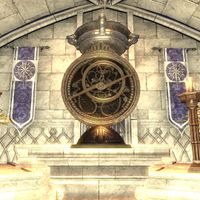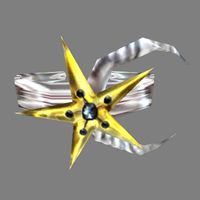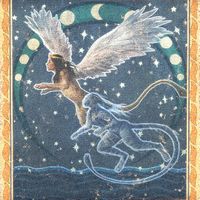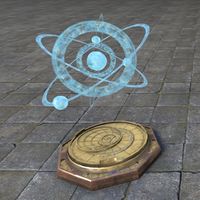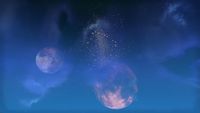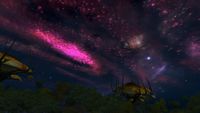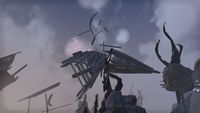User:Vincentius1/Sandbox 4
| All users are allowed to edit this user page. |

Stars are bright lights in the night sky. Many of these stars are bundled together and form the Constellations.[1] The general myth regarding stars and their creation is that they are tears in the veil of Oblivion and lead to Aetherius.[2][3][UOL 1] They were created by the God of Magic, Magnus and his children of divine beings, the Magna Ge after the creation of Nirn. Just as the Sun, the biggest tear of them all is associated with Magnus, each of the stars corresponds to their respective Magna Ge.[4] Nine of these spirits, who were separated from Magnus and the other Magna Ge during his departure are known as the Star-Orphans, or the Nine Coruscations to the Ayleids[4]
Another myth about the stars is that they are the blood of Anu and that its mingling with the blood of Padomay, the Daedra created the Aedra.[5]
The Wayshrines of Tamriel are theorized by the Arch-Conjurer of Clan Direnni, Corvus Direnni to correspond with the stars since Mundus is believed to be a reflection of Aetherius.[2] The stars are used in navigation, whether it is seafarers or travelers using the stars themselves or star charts,[6][7] or for interplanar travel to Aetherius, as used by explorers like the Sun Birds of Alinor or the Reman Dynasty expeditionaries.[8]
Stars are often used by the denizens of Tamriel as signs foretelling the future[9][10][11] or having a specific meaning. The Three Stars of Locanda glowing in the night, for example, stand for unholy alliances.[12] Warning signs in the stars can sometimes signal the angry passions of a Demigod.[13] The stars emit a unique type of magicka called Varliance.[14][15] It is considered the purest type of light by the Ayleids, who would harness this power in Ayleid wells found across the Tamrielic wilderness.[16]
A misnomer attributed to the stars are shooting stars. On a smaller scale, these are bits of celestial matter and magic from Aetherius and even Oblivion that moves across the sky and sometimes fall into Nirn.[17][UOL 1] Larger shooting stars are actually celestial bodies like a planet or a moonlit, like the Rogue Plane Baan Dar[UOL 1] or Baar Dau.[18] Shooting stars can contain two types of material called Meteoric Glass and Meteoric Iron, each of which have great magical potency.[17] There are other miscellaneous materials associated with the stars, like Stardust,[19][20] Starmetal,[21] and Star Sapphires.[22]
Contents
Known Stars[edit]
|
|
The Stars in other cultures[edit]
Altmer[edit]
Altmer myths claim that stars were created by the Magna Ge, Anuic spirits that fled Creation after the departure of its architect, the god Magnus,[4] who made the world.[2][3][24] Magnus himself left the greatest tear in the firmament: the Sun, sometimes named Magnus.[25][26][18] Another Aldmeri myth claims the stars were instead created from the blood of Anu. Some believe that stars are "fragments" of Magnus.[24]
Ayleid[edit]
The Ayleidoon word for star is varla.
As stated above, starlight is considered the purest form of light to the Ayleids. Meridia
Bosmer[edit]
The Bosmer believe that Y'ffre, the elven god of the forest and song,[27][28] sings to Aetherius and created a song so beautiful that the stars danced to it. They also say the stars still wink and blink in memory to it.[3] A similar exists among the Dark Elves.[28]
Daedra/Oblivion[edit]
Stars, aptly known as daedra stars[29] or daedric stars[30] have an association with the eponymous Daedra. Typically it is believed that when these stars darken, it is to mark the death of a daedra.[29][31]
Since the stars can determine fate and prophecy, the Daedric Prince of this sphere; Hermaeus Mora is associated with them.[32] The Sidereal Cloisters is a facility in Apocrypha where Ciphers of the Eye chart and study the stars to uncover their secrets and predict futures.[33] Hermaeus Mora themself is adamant in keeping the cloisters' secrets from ever leaving.[34]
Vaermina's faithful believe their patron "lights the sky of our world" and "is the stars of our world". They believed that "her thousand truths are a thousand lights in the night sky".[35] Certain stars themselves are associated with a specific prince, such as the stars of Mehrunes Dagon[36] and the stars of Namira, the latter of which people claim are "Always Hungry, never satisfied".[37] Most famous of all is the one related to the eponymous prince; Azura's Star, also called the twilight star. It only appears briefly just low on the horizon, during the dusk and dawn, and below the Steed constellation.[38]
Dunmer[edit]
Although Hermaeus Mora is acknowledged as the prince of fate and prophecy, in Dunmer religion, these traits are associated with Azura. This even extends to the prince's fated champion, the Nerevarine.[39] Their most recognized artifact is the ring, Moon-and-Star, which was blessed by Azura and gives the warrior indisputable proof of identity. From the lost prophecies written in the Apographa, the hidden teachings of the Tribunal, the Nerevarine is considered "far-star-marked" and "star-blessed". Abbot Gilvas Barelo of the Holamayan monastery noted his interpretations of the prophecy. He connects "far-star-marked" with the hero being born under foreign stars and links "star-blessed" with Azura.[39]
In Tribunal mythology, the stars are connected to Almalexia.[40][41] In the thirteenth sermon of Vivec's thirty-six lessons, the Warrior-Poet calls Ayem the star that forms when unraveling the magical cross and triangle that represents the Triune house.[42] One of Vivec's monster children was named Ha-Note. He found root in villages, where he learned from them a veiled astrology and the star charts of culture. He traveled to the Adjacent Place where the Grabbers turned him into City-Face.[43] Taking the stars and the cosmos as inspiration, Sotha Sil kept his memories in manufactured memory stones he called stars and stored them in a great orrery representative of his thoughts called the Mnemonic Planisphere.[44][45][46]
Though the Dunmer have forsaken much of their Aldmeri roots, including their veneration to the elven divines,[47] a sect of them continue to acknowledge Jephre.[28] Similar to the belief in Bosmer theology,[3] the Dark Elves have a legend that on the first day, Jephre walked the earth and weaved a beautiful song that swayed the stars above him. They say that stars still wink and blink in memory of his song and due to his influence, Elven bards pay homage to him.[28]
Divines/Aedra[edit]
The eight planets, each of whom are named after the Divines are sometimes called stars. In the 33rd sermon of Vivec's thirty-six lessons, the planets, Akatosh, Arkay, and Julianos are known as the north-pole-star, the south-pole-star, and the third-pole-star respectively.[18] These are made in reference to their position on their respective constellations, the Warrior, the Thief, and the Mage as their eye.[UOL 1] In the historical-fiction, King Edward, the character Aliera makes note of Zenithar, a large blue star near Secunda, the eastern moon.[48] Sometimes this blue star is a symbol of the divine.[49]
People often invoke Kynareth, the deity of the heavens, for auspicious stars at a child's birth.[50]
Khajiit[edit]
Sands Behind the Stars
An ancient myth revolves around the master jumper Anahbi, who once jumped so high they fell into Oblivion. Before she could be lost forever, the Two Moons, Jone and Jode saved her. Anahbi then stole Jone's light and leaped back to Nirn. The moons followed suit and danced a spiral across the sky, but collided and became entangled together. Anahbi took the opportunity to steal Jode's light as well. But before she could escape, the Two Moons caught her again. They returned her to her home in Quin'rawl, if she never attempted to steal their light and reach the stars again. Stardust was sprinkled on her brow to remind her of her vow.[19]
Nede[edit]
Ancient Nedic people of Craglorn followed the religion known as the Cult of the Stars.[52][53]
Nord/Atmoran[edit]
Two stars in Atmoran astronomy are known as Darumzu and Harakk, and these were particularly favored. They were also the namesake of Yngol and Ylgar's ships, which took them across the Sea of Ghosts from Atmora to Skyrim and back.[55] Though its name is in reference to the Sun, the city of Dawnstar is located on the north-central coast of Skyrim.[56]
Reachmen[edit]
Some Reachfolk Witches can read the stars and see the future and hidden truths in their light.[57] Similar practices could be observed among the inhabitants of the Iliac Bay.[58]
Starsinger Clan is one of many Reachfolk clans in the eponymous region. For a time, they lived in Cyrodiil under Emperor Moricar.[59][60]
Redguard/Yokudan[edit]
Redguards believe that the stars were created by Ruptga as a way to guide spirits to the far shores.[25][61] In Yokudan folklore, there is an entity known as the Star Man, who studied the stars and charted their movements. He especially favored the Warrior constellation and recorded its path in the night sky.[62]
Starmetal is an unknown type of metal that the Redguards use regularly in their style of crafting.[21] The Yokudans use to have starstones.[63] The city-state of Dragonstar is located on the northernmost corner of Hammerfell.[64]
Gallery[edit]
-
Star-like phenomenon in the Spilled Sand
-
Stars and constellations in the Shivering Isles on a clear night
-
The moons and stars visible in a cloudy sky in the Fathoms Drift
References[edit]
- ^ The Firmament — Ffoulke
- ^ a b c Wayshrines of Tamriel — Beredalmo the Signifier
- ^ a b c d Girnalin's dialogue in ESO
- ^ a b c Exegesis of Merid-Nunda — Phrastus of Elinhir
- ^ The Annotated Anuad
- ^ Captain Wayfinder's dialogue in Skyrim
- ^ Midyear Star Chart treasure text in ESO: High Isle
- ^ Pocket Guide to the Empire, 3rd Edition: Arena Supermundus: The Tapestry of Heaven — Imperial Geographical Society, 3E 432
- ^ Emperor Uriel Septim's dialogue in Oblivion
- ^ Oracle rumors in Daggerfall
- ^ Worn, Faded Note — Ghola gro-Muzgol
- ^ The Vampire Relic quest in Daggerfall
- ^ The Ancient Watcher success rumors in Daggerfall
- ^ Naryu's Journal/Hew's Bane — Naryu Virian
- ^ High Astrologer Caecilus Bursio Answers Your Questions — High Astrologer Caecilus Bursio
- ^ Magic from the Sky — Irlav Jarol
- ^ a b Aetherial Fragments
- ^ a b c 36 Lessons of Vivec, Sermon 33 — Vivec
- ^ a b A Dance in Moonlight
- ^ Vial of Stardust treasure text in ESO
- ^ a b Starmetal in ESO
- ^ Star Sapphire in ESO
- ^ a b Calcinator Treatise
- ^ a b The Infernal City — Greg Keyes
- ^ a b Varieties of Faith in the Empire — Brother Mikhael Karkuxor of the Imperial College
- ^ Before the Ages of Man — Aicantar of Shimerene
- ^ Varieties of Faith... — Brother Mikhael Karkuxor of the Imperial College
- ^ a b c d Of Jephre — Anonymous
- ^ a b A Test of Determination rumors in Daggerfall
- ^ Background Information in Daggerfall
- ^ The Daedra's Heart success rumors in Daggerfall
- ^ The Book of Daedra
- ^ Meenai-Shai's dialogue in ESO: Necrom
- ^ The Sidereal Cloisters loading screen text in ESO: Necrom
- ^ In Dreams We Awaken
- ^ Mehrunes Dagon's Quest failed rumors in Daggerfall
- ^ Namira's Quest success rumors in Daggerfall
- ^ The Anticipations — Anonymous
- ^ a b The Lost Prophecy — Gilvas Barelo
- ^ 36 Lessons of Vivec, Sermon 11 — Vivec
- ^ 36 Lessons of Vivec, Sermon 36 — Vivec
- ^ 36 Lessons of Vivec, Sermon 13 — Vivec
- ^ 36 Lessons of Vivec, Sermon 30 — Vivec
- ^ The Memories of Sotha Sil — Varlinsi Arandu, Apostle of Sotha Sil
- ^ Mnemonic Star-Sphere antiquity codex entries in ESO: Greymoor
- ^ Amili Lloryn's dialogue in ESO: Clockwork City
- ^ Varieties of Faith: The Dark Elves — Brother Mikhael Karkuxor of the Imperial College
- ^ King Edward, Part VIII — Anonymous
- ^ Zenithar's Measure treasure text in ESO
- ^ Kynareth generic description in Morrowind
- ^ Words of Clan Mother Ahnissi — Clan Mother Ahnissi
- ^ Erold's dialogue in ESO
- ^ Nhalan's dialogue in ESO
- ^ The Raneviad, Volume II
- ^ Songs of the Return, Vol 2
- ^ Dawnstar location and rumors in Arena
- ^ Arana's dialogue during Blood of the Reach in ESO: Markarth
- ^ Oracle in Daggerfall
- ^ Medresi Guvron's dialogue in ESO: Markarth
- ^ Linwuuruben's dialogue in ESO: Markarth
- ^ Tall Papa's Lamp antiquity codex entries in ESO: Greymoor
- ^ How the Yokudans Chased the Stars
- ^ Starstone quest item in Redguard
- ^ Dragonstar location and rumors in Arena
Note: The following references are considered to be unofficial sources. They are included to round off this article and may not be authoritative or conclusive.
